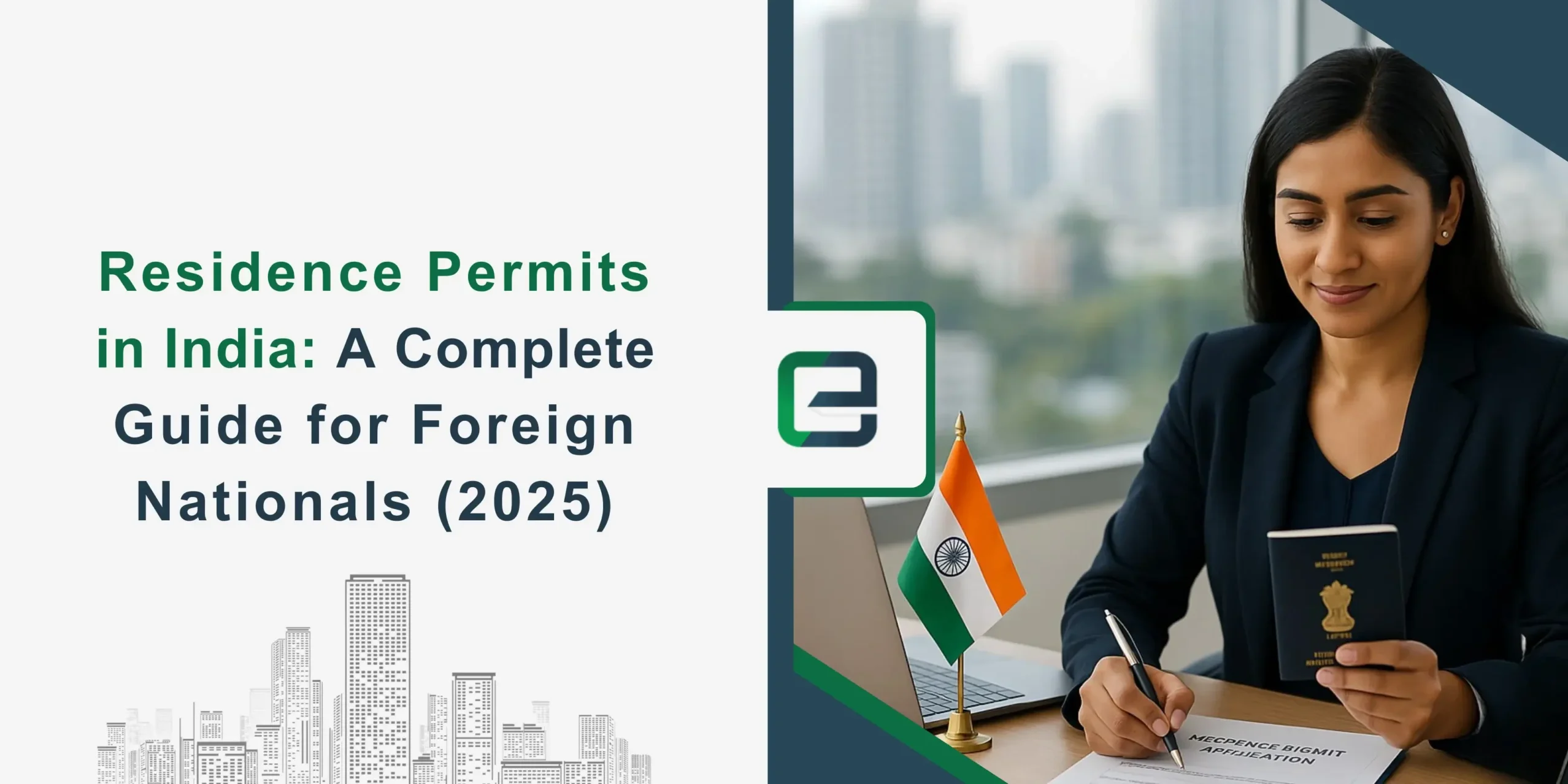India remains a key destination for global professionals, entrepreneurs, researchers, and families. Whether you’re moving for work, business, study, or family reunification, a residence permit is essential for a long-term legal stay.
This guide provides a clear overview of who needs a residence permit, the types available, how to apply, and the long-term residency options for foreign nationals in 2025.
Who Needs a Residence Permit in India?
Foreign nationals planning to stay in India for an extended period for work, study, business, or family purposes must obtain a residence permit. The FRRO or FRO issues this after arrival. It proves legal residency under a long-term visa.
According to Indian immigration rules, anyone staying in the country for more than 180 days must register with the FRRO or FRO within 14 days of arrival. Successful registration provides a residence permit, which must be renewed based on visa conditions and the length of stay.
You’ll need a residence permit (via FRRO registration) if you fall into any of the following categories:
Why Foreigners Need a Residence Permit in India?
India is one of the world’s fastest-growing economies. It attracts foreign professionals, entrepreneurs, students, and families. As more people relocate for work, business, education, healthcare, or family, obtaining the correct residency documentation, including a valid residence permit in India, is crucial.
In India, you obtain a residence permit through a long-term visa and mandatory registration with the FRRO or FRO. This allows you to stay legally beyond the limits of short-term visas.
Unlike short-term visitors, foreign residents must declare their purpose, duration, and address in India to comply with immigration laws. This permit is more than just a formality; it is a legal requirement for long-term stays and access to essential services.
Also Read: Registration of a Foreign Company in India
Overview of Residence Visa Options for Foreign Nationals in India
Which visa fits your purpose of stay?
India doesn’t issue a single “residence permit” card like some countries. Instead, your residence visa type determines your ability to live in India in the long term. Once you arrive, completing FRRO (Foreigners Regional Registration Office) registration—typically required for stays exceeding 180 days—activates your legal residency in India.
Whether you’re starting a business, working at a company, reuniting with family, or pursuing higher education, there’s a long-term visa tailored to your purpose.
Let’s walk through the most common types of residence permits in India, and what each one allows you to do.
How to Apply for a Residence Permit in India?
Foreign nationals planning to stay in India for more than 180 days must obtain a residence permit in India by registering with the Foreigners Regional Registration Office (FRRO) or Foreigners Registration Office (FRO). This process is now fully online via the official e-FRRO portal.
Step-by-Step Application Process
1. Register on the e-FRRO Portal
- Visit indianfrro.gov.in
- Create an account using a valid email ID and an Indian mobile number.
2. Select the Required Service
- Log in and choose the appropriate service, such as
- Registration
- Visa extension
- Residence permit issuance
3. Fill Out the Application Form
- Enter accurate details, including personal information, visa data, and your Indian address.
4. Upload Required Documents
Submit clear, scanned copies of:
- Valid passport with a visa page
- Passport-size photo (as per FRRO specifications)
- Proof of residence in India (e.g., rental agreement, Form C from hotel/landlord)
- Visa-specific documents (e.g., job offer, university admission letter)
5. Pay the Applicable Fees
- Make payment online through the e-FRRO portal.
- Fees vary depending on visa type.
6. Track and Respond to Updates
- Application status will be communicated via SMS/email.
- Attend an in-person appointment at the FRRO/FRO if required.
7. Download Your Residence Permit
- Once approved, your Residence Permit (Registration Certificate) will be available for download in your e-FRRO account.
Documents Typically Required
- A passport with a valid visa and an arrival stamp
- Recent passport-size photographs
- Address proof in India (e.g., lease agreement, utility bill, Form C)
- Visa-specific supporting documents
- e.g., employment contract for a work visa
- admission letter for student visa
- Letter of undertaking from the sponsoring employer or institution (if applicable)
- Medical certificate (for visa durations over one year)
Duration, Renewal, and Extension of Residence Permits
The validity of a residence permit in India is based on the type and duration of the foreign national’s long-term visa. Typically, permits are valid for 1 to 5 years, depending on the purpose of stay, such as employment, education, business, or family reunification under an appropriate permit of residence.
To continue residing in India legally, applicants must renew or extend their residence permit before it expires, ideally at least 60 days before the expiration date.
Key Points to Remember
- Renewal applications must include updated, visa-specific documents:
- Employment contract
- Admission/enrollment letter
- Proof of familial relationship (e.g., marriage/birth certificate)
- Additional required documents:
- Valid passport with visa
- Recent passport-size photographs
- Updated Indian address proof (e.g., rental lease, Form C)
- Consequences of overstaying without renewal:
- Monetary penalties
- Cancellation of the current visa
- Possible blacklisting or refusal of future Indian visas
- Final approval is at the discretion of the FRRO/FRO. Based on document verification and immigration compliance.
Pathway to Long-Term Residency and Citizenship in India
India does not offer a standard permanent residency program for most foreigners, but certain visa categories—especially for spouses of Indian citizens, Persons of Indian Origin (PIOs), or Overseas Citizen of India (OCI) cardholders—can lead to long-term residence. The OCI card, in particular, offers lifelong residency and multiple-entry rights, although it does not grant full citizenship or political rights. It is intended for individuals with strong familial or ancestral ties to India.
For those seeking Indian citizenship, the Citizenship Act, 1955, requires at least 11 years of legal residence, including one year of continuous stay immediately before applying. Applicants must also demonstrate good character, basic knowledge of a local language, and allegiance to the Constitution. While the process is selective, it offers a clear legal path for well-settled foreign nationals to obtain permanent residency or Indian citizenship through valid residence permits.
Common Issues and How to Avoid Rejection of a Residence Permit in India
Common Mistakes to Avoid When Applying for a Residence Permit or Visa Extension in India:
- Incomplete documentation submission
- Incorrect or mismatched personal information details
- Delayed FRRO registration beyond the stipulated timeline
- Missing visa-specific documents (e.g., job offer letters, university admission letters)
- Overstaying a previous visa or failing to renew it on time
Tips to Avoid Delays or Rejections:
- Ensure all documents are accurate, complete, up-to-date, and properly scanned
- Submit your application well before the deadline
- Regularly check email and SMS notifications from the e-FRRO portal
- Consult your sponsoring employer, educational institution, or an immigration expert if unsure
- Follow the official FRRO guidelines at every stage of the process
Conclusion: Staying Compliant While Living in India
Living in India long-term requires more than just the right visa. It requires timely registration, accurate documentation, and adherence to immigration rules. Staying compliant ensures a smooth and legal stay. It also opens the door to future opportunities, such as visa renewals, OCI status, or even citizenship. Always stay informed and proactive to avoid disruptions during your time in India.
At 3E Accounting India, we specialize in making this process seamless—from incorporation to regulatory filings—so you can focus on execution while we handle the complexities
Get Your Indian Residence Permit With Confidence
Apply for your residence permit in India quickly and correctly—let 3E Accounting guide you through FRRO registration and long-term visa compliance so you can focus on your life and work abroad.
Frequently Asked Questions
A residence permit in India is official authorization for foreign nationals to stay in the country long-term (typically beyond 180 days). Issued after FRRO/FRO registration, it’s tied to visas like employment, business, student, or medical. While India doesn’t offer a “green card” or permanent residency, a residence permit ensures legal compliance and access to services like housing, banking, and telecom.
A residence permit in India allows foreign nationals to stay in the country long-term, depending on their visa type (such as employment, student, or business), and is issued through FRRO/FRO registration. It must be renewed as per visa validity.
India does not offer a general permanent residency or a green card. However, OCI cardholders (Overseas Citizens of India) enjoy several long-term residency benefits, including visa-free travel and the right to live in India indefinitely, although they are not entitled to voting or government job rights.
No, a residence permit is not the same as a visa. A visa allows you to enter India, while a residence permit (issued after FRRO/FRO registration) allows you to legally stay in India for more than 180 days under long-term visa categories like employment, student, or business.
Permanent residency in India, such as through the Overseas Citizen of India (OCI) card, enables foreign nationals to reside, work, and travel freely in India, often for an extended period. However, it does not grant political rights, such as voting, holding public office, or obtaining an Indian passport. Indian citizenship, on the other hand, gives you full legal rights, including voting, contesting elections, and accessing government jobs. It also requires renouncing your previous nationality, as India does not allow dual citizenship.
No, India does not have an official “green card” system like the U.S. Instead, the term “green card of India” is informally used to refer to the residence permit granted to foreign nationals holding long-term visas. This permit is issued by the FRRO (Foreigners’ Regional Registration Office) or FRO (Foreigners’ Registration Office) and allows for legal residence in India beyond the duration of short-term visas.

Abigail Yu
Author
Abigail Yu oversees executive leadership at 3E Accounting Group, leading operations, IT solutions, public relations, and digital marketing to drive business success. She holds an honors degree in Communication and New Media from the National University of Singapore and is highly skilled in crisis management, financial communication, and corporate communications.







